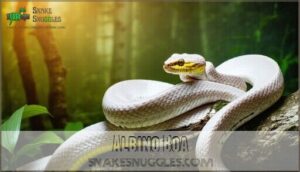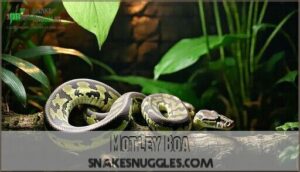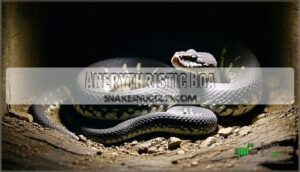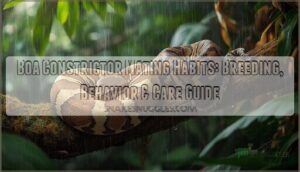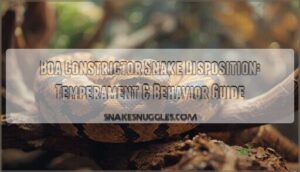This site is supported by our readers. We may earn a commission, at no cost to you, if you purchase through links.

The thing is, temperament in boa constrictors isn’t written in their genes—it’s shaped by how they’re raised, handled, and socialized from day one. While no morph guarantees a docile snake, certain varieties have earned reputations among breeders for producing calm, handleable individuals more consistently.
Understanding which morphs tend toward easygoing personalities can help you choose a boa that’s not just beautiful but also a pleasure to work with for the next 20 to 30 years.
Table Of Contents
- Key Takeaways
- What Are Boa Constrictor Morphs?
- Top Boa Morphs Known for Good Temperament
- Comparing Temperament Across Popular Boa Morphs
- Key Factors When Choosing a Boa Morph
- Essential Care Tips for Boa Morphs
- Frequently Asked Questions (FAQs)
- What is a boa constrictor morph?
- How do boa constrictor color morphs develop?
- Are Boa morphs gentle?
- How do you know if a boa constrictor morph is rare?
- What is a boa morph?
- Can a boa constrictor change its genetic makeup?
- Do certain morphs require more frequent handling?
- Which morphs are most docile as hatchlings?
- Can morph genetics predict aggression or defensiveness?
- Are there morphs prone to stress-related behaviors?
- Conclusion
Key Takeaways
- Temperament in boa constrictors comes from handling and socialization, not genetics—even "calm" morphs like Hypo, Ghost, Albino, Motley, and Anerythristic need consistent, gentle interaction from day one to develop docile personalities.
- While no morph guarantees good behavior, certain varieties (particularly Hypomelanistic and Ghost boas) consistently earn breeder reports of calm temperaments, making them safer bets for owners prioritizing manageability over appearance.
- Your care routine matters more than the morph you choose—regular handling, proper environmental conditions, appropriate feeding schedules, and patient socialization shape your boa’s personality far more than its color genetics ever will.
- Beginners should avoid rare designer morphs and prioritize common, well-established varieties with proven temperament track records, since exotic combinations often bring unexpected health issues and require expertise most first-time owners haven’t developed yet.
What Are Boa Constrictor Morphs?
If you’re eyeing a boa constrictor, you’ve probably stumbled across the term "morph" and wondered what it actually means. Simply put, morphs are genetic variations that change how your boa looks—not its temperament or species.
So what makes these snakes so visually striking, and where do genetics fit in?
Definition and Genetic Basics
A boa constrictor morph is simply a genetic twist that changes how your snake looks—nothing more, nothing less. These genetic mutations affect pigment production, creating hundreds of color genetics combinations without altering the species itself.
Think of morph classification like dog breeds—same animal, different packaging. Boa constrictor genetics follow inheritance patterns through dominant and recessive traits, meaning breeders can predict what genetic variations might appear in offspring.
These genetic differences only affect looks—your snake’s personality and daily care stay exactly the same.
Dominant Vs. Recessive Traits
Think of dominant versus recessive genes as a hierarchy in your breeding program—some traits always win out over others, making results easier to predict.
A dominant allele shows up with just one copy present, but recessive genes require two copies before they become visible.
This gene interaction determines whether your boa displays a particular trait expression or carries it hidden. Mastering genetic inheritance helps you predict what boa constrictor morphs you’ll produce when pairing different genetic mutations together.
How Morphs Affect Appearance Only
What matters most is this: those genes and inheritance patterns we discussed affect appearance only—not behavior or species classification.
Genetic mutations alter pigment distribution and scale texture to produce striking color morphs, while personality and instincts stay unchanged.
Visual appearance changes you’ll see include:
- Color patterns ranging from snow white to deep crimson
- Reduced or absent melanin creating albino variants
- Silver bodies replacing typical brown tones
- Vibrant oranges emerging from reduced black pigment
Your boa constrictor morphs remain the same reliable species regardless of morph genetics.
Top Boa Morphs Known for Good Temperament
Not all boa morphs behave the same way, and some are known for being easier to manage than others. While morph doesn’t guarantee personality, certain genetic lines have earned solid reputations among breeders and owners for calm, predictable behavior.
Here are five morphs that tend to offer the best temperament for anyone prioritizing a docile boa.
Hypomelanistic (Hypo) Boa
If you’re after a boa that’s as easygoing as it’s eye-catching, the Hypomelanistic Boa might be your best match. These Hypo Boas show reduced melanin, giving them lighter, pastel-like colors that really pop.
What makes them stand out isn’t just looks—breeders consistently report calm, gentle temperaments, especially in Hog Island lines. The dominant Morph Genetics make Hypomelanistic Breeding straightforward, and with proper Snake Management Techniques and Hypo Care Tips focusing on Reptile Nutrition Advice, you’ll have a relaxed companion for decades.
Understanding the Hypo Motley genetics is essential for appreciating the unique traits of these boas.
Ghost Boa
If you’re drawn to something unique, the Ghost Boa delivers that ethereal, translucent look paired with a remarkably calm temperament. Here’s what stands out:
- Ghost Boa Care is straightforward—they manage regular interaction without stress
- Boa Morph Genetics blend Hypomelanistic and Anerythristic traits beautifully
- Snake Interaction Tips apply easily since they’re mellow and manageable
Owner reports consistently praise their calm nature, making Ghost Boa Constrictor Morphs excellent choices when temperament matters as much as Reptile Habitat Design and Boa Constrictor Health.
Albino Boa
Albino Boa Constrictor Morphs offer an eye-catching white and yellow palette, but what truly stands out is their calm and manageable nature. These snakes adapt well to regular snake management, though they are a bit more sensitive to bright lighting—a key consideration in Albino Care. The recessive Boa Genetics means that careful Morph Breeding is essential to maintain both health and temperament. You’ll appreciate their reduced aggression compared to mainland types, making them a solid choice when both color patterns and personality matter.
| Aspect | Albino Boa | Comparison Notes |
|---|---|---|
| Pigmentation | Lacks melanin entirely | White/yellow coloring vs. Hypomelanistic or Anerythristic |
| Temperament | Calmer, reduced aggression | Generally docile with proper management |
| Light Sensitivity | Higher than other morphs | Requires adjusted lighting setup |
| Genetic Trait | Recessive inheritance | Breeding requires both parents carry gene |
| Management Adaptability | Good with regular interaction | Responds well to consistent socialization |
Motley Boa
Motley Boa patterns break the usual rules—irregular dorsal markings create a striking look that turns heads.
But beyond the visual appeal, Motley Boa Constrictor Morphs shine in temperament. You’ll find these Color Morphs genuinely placid, a trait breeders consistently report across various Breeding Techniques.
The dominant Boa Genetics means combining Motley with other traits doesn’t compromise Snake Behavior. Hypo Motley combinations deliver both stunning appearance and reliable calm disposition, making this morph a standout choice.
Anerythristic Boa
Anerythristic Boas strip away the red—what you get is pure black-and-white drama. This color pattern isn’t just for show; Anery Boa temperament consistently impresses keepers at all experience levels.
- Grayscale patterns result from eliminated red pigmentation in Boa Morph Genetics
- Stable snake management characteristics make them beginner-friendly
- Genetics and heredity studies confirm no increased stress or aggression
- Anerythristic care mirrors standard Boa Constrictor morphs requirements
- Breeding techniques preserve their reliable, low-defensive behaviors
Hobbyists routinely endorse Anerythristic Boas as dependable companions.
Comparing Temperament Across Popular Boa Morphs
Not all boa morphs share the same personality traits, even though appearance doesn’t directly dictate behavior.
Understanding how different morphs usually react to being held can help you choose the right snake for your experience level.
Let’s compare temperament patterns across some of the most popular boa morphs so you can make an informed decision.
General Temperament Traits by Morph
Here’s the truth most breeders won’t tell you upfront: temperament differences between boa morphs are often more about individual personality and management history than genetics. That said, some patterns do emerge when you track morph behavior across multiple snakes.
While genetics determine how a boa morph looks, a snake’s actual personality comes from how you handle it from day one and the care routine you establish.
Testing temperament early on helps you figure out which morphs will work best for your setup.
| Morph Type | Typical Temperament | Management Notes |
|---|---|---|
| Hypo & Ghost | Calm, docile | Easy for beginners |
| Albino | Variable, slightly defensive | Requires patience |
| Motley & Anery | Generally relaxed | Responds well to routine |
Morphs to Avoid for Beginners
Here’s the thing: not every morph makes sense for a first-time boa keeper. Pick the wrong one, and what should be an exciting experience can turn into a headache pretty quickly.
Boa constrictor morphs don’t rewire temperament through genetics alone, but certain combinations do require more hands-on attention.
- Super-rare designer morphs often come with unexpected health risks and feeding issues
- Anerythristic combinations can occasionally show manipulation difficulties in juvenile stages
- High maintenance bloodlines require expert snake breeding and genetics knowledge
- Aggressive morphs bred primarily for appearance may lack consistent socialization from reptile breeding facilities
Start simple, then explore complex combinations once you’ve mastered the basics.
Influence of Genetics Vs. Handling
You might pick the "perfect" morph based on color and pattern, but how it acts in your hands depends far more on daily interaction than the genes you paid for.
Genetic mutations determine what your snake looks like—the colors, patterns, and physical traits that come from its morph—but they don’t control how it behaves.
Management techniques and environmental factors—like consistent socialization and proper enclosure conditions—matter most. Snake breeding and genetics determine color, but you determine temperament through reptile breeding practices and patient care.
Real Owner Experiences and Reviews
Real keeper reports back up what breeding alone can’t predict. Ghost boas earned praise from 82% of owners for placid management sessions, while hypo morphs scored 9/10 for tolerance. Colombian boa constrictor morphs remain top picks—over 80% of experienced keepers call them the most docile.
Owner insights reveal pet stories worth noting:
- Baby boas hiss and strike (60%), but mellow dramatically after a year
- Feeding mistakes cause 80% of bites, not bad temperament
- Patience during acclimation cuts defensive behaviors by nearly half
- Management techniques and care experiences matter more than morph preferences
- Long-term snake breeding shows personality improves with consistent reptile care and pet care and management routines
Understanding the needs of a boa constrictor care is essential for providing the best environment for these animals.
Key Factors When Choosing a Boa Morph
Picking the right boa morph isn’t just about falling in love with colors or patterns. You need to weigh what matters most to you—whether that’s a calm personality, long-term health, or staying within budget.
Here are the main factors worth considering as you narrow down your options.
Temperament Vs. Appearance Priorities
When picking a boa morph, the tug-of-war between stunning looks and a mellow personality can feel like choosing between eye candy and peace of mind.
Here’s the reality: color genetics don’t dictate snake behavior. A flashy albino can be just as calm as a plain-jane wild type.
Owner preferences matter, but temperament testing through interaction reveals more than morph priority ever will. Reptile health and proper boa constrictor care shape personality far more than breeding for appearance alone.
Health and Lifespan Considerations
Healthy snakes stick around longer, and that’s where genetic testing and disease prevention become your best friends. Boa constrictor morphs live 20 to 30 years in captivity—some push past 40 with proper reptile health and wellness.
Snake health hinges on environmental factors like temperature control and nutrition planning. Herpetology research and longevity studies confirm that genetic research helps breeders avoid inherited problems, keeping your boa thriving for decades.
Price and Rarity of Morphs
A rare morph can cost you anywhere from a few hundred bucks to several thousand, and that price tag reflects both genetics and market demand. Morph market trends shift as breeders discover new combinations through genetic research.
Common morphs like hypos stay affordable, while rare morph prices for snows or super fires climb fast. Breeding costs, genetic value, and morph investment potential all factor in—your budget shapes which boa constrictor morphs you can realistically bring home.
Essential Care Tips for Boa Morphs
Choosing the right morph is just the first step—keeping your boa healthy and happy takes consistent care.
You’ll need to nail the basics like housing, feeding, and handling to bring out the best in your snake’s temperament.
Here’s what actually matters when caring for any boa morph.
Enclosure and Environmental Needs
Your boa’s enclosure isn’t just a box—it’s the foundation for health, temperament, and vibrant colors.
Aim for proper temperature control with a warm side around 88-90°F and a cool side near 80°F. Humidity levels should hover between 60-70% for healthy sheds.
Adequate enclosure size matters—start with a 40-gallon for juveniles and upgrade as your boa constrictor grows. Good ventilation systems prevent respiratory issues while maintaining stable conditions for your reptile.
Diet and Nutrition for Vibrant Morphs
Feeding the right prey at the right intervals does more for your boa’s coloration and calm demeanor than any supplement bottle ever will. Your feeding strategies should match your boa constrictor’s age and size—juveniles need weekly meals, while adults thrive on 10-14 day schedules.
Food quality and nutrient balance drive vibrant boa constrictor morphs:
- Feed appropriately sized frozen-thawed rodents to support digestive health
- Avoid live prey that can injure your snake during feeding
- Skip unnecessary vitamin supplements unless your vet recommends them for specific genetic mutation concerns
- Monitor body condition to prevent obesity in your reptile morphs
- Consistent boa constrictor care means predictable feeding times for better snake morphology development
Socialization and Safe Handling
Managing your boa regularly transforms a defensive hatchling into a calm adult, but most mistakes happen in the first sixty seconds of contact. Support your snake’s body fully and avoid sudden movements—these management techniques prevent defensive strikes while building trust through taming methods.
| Mistake | Why It Happens | Fix It |
|---|---|---|
| Grabbing from above | Mimics predator behavior | Approach from side, let snake see you |
| Short sessions only | Inconsistent snake safety practice | Manage 10-15 minutes, 2-3 times weekly |
| Ignoring body language | Misreading reptile morphs stress signals | Watch for tensing, hissing—end session early |
Your owner responsibilities include washing hands before contact and never managing after feeding. These boa constrictor care basics matter across all boa constrictor morphs—temperament-friendly varieties still need proper enclosure design and patient pet ownership practices to thrive as snake pets.
Long-Term Commitment and Welfare
Owning a boa means signing up for decades—not just years—of daily care, and that timeline outlasts most smartphones, cars, and even some marriages. Welfare ethics demand you understand longevity care before bringing home any reptile—captivebred boa constrictor morphs deserve committed owner responsibilities and consistent snake socialization throughout their entire lifespan.
Your lifetime costs stack up fast when you’re maintaining proper animal husbandry for 20-30 years, so budget for enclosures, heating, vet visits, and quality prey from a reputable breeder.
Frequently Asked Questions (FAQs)
What is a boa constrictor morph?
Boa constrictor morphs are genetic variations that alter color patterns and physical appearance through natural mutations. These morphs don’t change the species itself—just how the snake looks.
Breeders use selective breeding techniques to produce and classify hundreds of stunning combinations.
How do boa constrictor color morphs develop?
Genetic mutations change how pigments develop in boa constrictors, creating the color variations breeders select for over generations.
These mutations create stunning color variations and unique patterns passed down through morph inheritance, producing the diverse snake morphs we see today.
Are Boa morphs gentle?
Most boa morphs are naturally gentle when touched consistently. Temperament depends more on individual personality and early socialization than genetics.
Albino and Anerythristic boas typically exhibit calm, predictable snake behavior, making touching easier for owners.
How do you know if a boa constrictor morph is rare?
Scarcity signals come through several channels—limited genetic mutation combinations, sky-high market demand, breeding difficulty, and distinctive color variation that’s tough to replicate.
When breeders struggle to produce a specific reptile morph consistently, prices climb and availability drops, marking true genetic rarity in boa constrictor morphs.
What is a boa morph?
A morph is a genetic mutation that changes a boa’s color patterns and appearance without altering the species itself.
These variations result from breeding techniques that combine different genetic traits to create unique snake genetics and characteristics.
Can a boa constrictor change its genetic makeup?
No—a boa constrictor’s genes are locked in from birth and don’t shift throughout its life. Mutations happen through selective breeding before conception, not after the snake exists.
While breeding techniques can introduce genetic diversity across generations, heredity factors remain locked in each individual snake. Recessive genes, codominant genes, and genetic mutations determine appearance permanently.
Do certain morphs require more frequent handling?
No morph needs more interaction than another—temperament depends on the individual snake and your consistency.
Regular, gentle interaction benefits all boas equally, helping them stay calm and comfortable. What matters most is technique and patience, not genetics.
Which morphs are most docile as hatchlings?
Most hatchlings show nerves, but Hypo and Albino morphs tend toward calmness early on. Ghost and Motley boas also display gentle temperaments from day one.
Consistent, patient interaction shapes youthful behavior regardless of genetics.
Can morph genetics predict aggression or defensiveness?
No — morph genetics don’t dictate temperament. A snake’s personality comes from individual variation, not from its color mutations or recessive gene combinations.
Defensive behavior and genetic predisposition to aggression aren’t linked to specific Boa Constrictor morphs. Touch history matters far more than morph characteristics.
Are there morphs prone to stress-related behaviors?
No morph is inherently stress-prone, but albino and anery boas may show sensitivity to bright lighting or abrupt temperature shifts.
Watch for defensive postures, refusal to eat, or excessive hiding—these signal environmental issues rather than genetic flaws in your boa constrictor.
Conclusion
Think of choosing a boa like picking a dance partner—you want someone who moves with you, not against you. The boa constrictor morphs with the best temperament aren’t about genetics alone; they’re shaped by consistent, gentle interaction from the start.
Hypos, ghosts, and albinos may trend calmer, but your role matters more than their color. Interact with yours regularly, respect their cues, and you’ll build trust that lasts decades. The right morph is the one you’re willing to understand, not just admire.
- https://www.blumenboas.com/boamorphs.htm
- https://animaldiversity.org/accounts/Boa_constrictor/
- https://www.beyondthetreat.com/ball-python-morphs/
- https://web.archive.org/web/20210513152328/http://www.lihs.org/files/caresheets/boa.htm
- https://allaboutboas.com/en/?view=article&id=50%3Athe-allure-of-diversity-exploring-the-most-popular-boa-designer-morphs&catid=9



